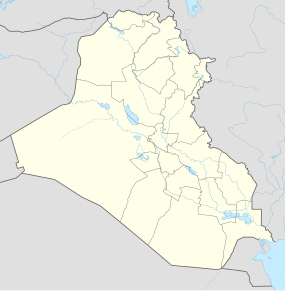Royal Cemetery at Ur
| Arabic: أور | |
| Location | Tell el-Muqayyar, Dhi Qar Province, Iraq |
|---|---|
| Region | Mesopotamia |
| Coordinates | 30°57′45″N 46°06′11″E / 30.96250°N 46.10306°ECoordinates: 30°57′45″N 46°06′11″E / 30.96250°N 46.10306°E |
| Type | Settlement |
| History | |
| Founded | c. 3800 BC |
| Abandoned | after 500 BC |
| Periods | Ubaid period to Iron Age |
| Cultures | Sumerian |
| Site notes | |
| Excavation dates | 1853-1854, 1922-1934 |
| Archaeologists | John Taylor, Leonard Woolley |
The Royal Cemetery at Ur is an archaeological site in modern-day Dhi Qar Governorate in southern Iraq. The initial excavations at Ur took place between 1922 and 1934 under the direction of Leonard Woolley in association with the British Museum and the University of Pennsylvania Museum of Archaeology and Anthropology in Philadelphia, Pennsylvania.
The process was begun in 1922 by digging trial trenches, in order for Woolley to get an idea of the layout of the ancient city. In one trench where initially nothing was discovered, head archaeologist Leonard Woolley decided to dig deeper. There, clay vases, limestone bowls, small bronze objects and assorted beads were found. Woolley thought that there may have been gold beads and, to entice the workers to turn them in when found, Woolley offered a sum of money—this led to the discovery of the gold beads after the workers repurchased them from the goldsmiths they sold them to.
Dishonesty of the workers was an issue, but not the only in the preliminary digs. The locals hired to help had no previous experience in archaeology, leading Woolley to abandon what they referred to as the "gold trench" for four years, until the workers became more well versed in archaeological digs. In addition, archaeology was still in the beginning stages as a field. As a result, gold objects were identified by an expert who dated them to the "Late Babylonian" (c. 700 BC), when in fact they dated back to the reign of Sargon I (c. 2300 BC).
The cemetery at Ur included just over 2000 burials. Amongst these burials were sixteen tombs identified by Woolley as "royal" terms based on their size and structure, variety and richness of grave goods as well as the existence of artifacts associated with mass ritual.
The ruins of the ancient city of Ur can be found in the desert of southern Iraq. The city remained abandoned after the Euphrates River changed its course more than two millennia ago. Early archaeologists, however, dug into the surface and recovered graves, some of which had royal names inscribed on them. Woolley began his excavation in 1922 on behalf of the British Museum and the University of Pennsylvania Museum of Archaeology and Anthropology. However, the actual discovery of the cemetery and its royal tombs was four years later after the excavation started. The large cemetery was in operation for at least three centuries during the second half of the third millennium BC. Most of the graves were individual burials that had cut into one another. Male and female corpses were found with their belongings that identified them as either rich or poor.
...
Wikipedia

